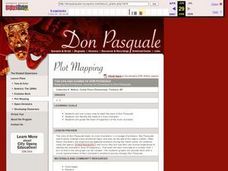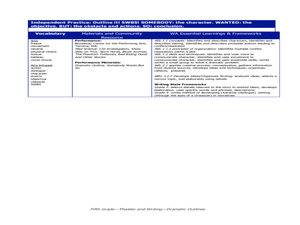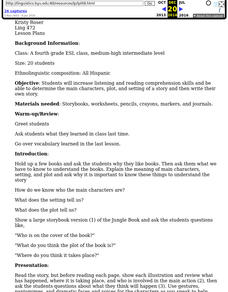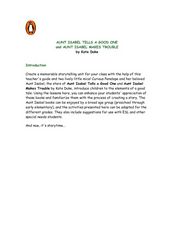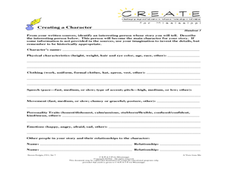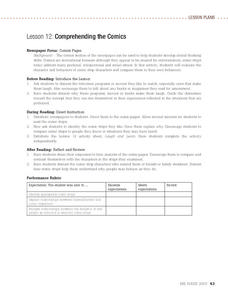Curated OER
CAN WE SWITCH GENDERS OF STORY CHARACTERS?
Analyze characters and stories to identify stereotyping. Learners will examine the concept of character gender to evaluate bias in classroom story books. They are asked to read a story or play and change the gender of the character to...
Curated OER
AWARD CERTIFICATE FOR A CHARACTER
Connect to real-world experiences by having your primary learners create an award certificate based upon literal and inferential information from a story. They present the award to a character from a story and explain the criteria used....
Curated OER
The Ups and Downs of don Pasquale: Mapping the Emotional Journey of Characters in Don Pasquale
Students listen to and retell the story of Don Pasquale. They evaluate the emotions of the main characters. Students create a graph of the emotions of Don Pasquale.
Curated OER
Write a Story
Here is a great way to explore narrative writing! Learners review a previously constructed story map and identify the characters, setting, and main events in the book Anansi and the Moss-Covered Rock retold by Eric A. Kimmel. They...
Curated OER
Dramatic Outlines
Young scholars write about main characters. In this dramatic writing lesson, students brainstorm character ideas. Young scholars create actions and give the character a voice. Students act out the scene in groups and create a final draft.
Curated OER
Language Practice
The simple instructional techniques described in this plan will help young readers learn and practice basic reading skills and strategies. Before reading, introduce your readers to the meaning of main character, setting, and plot. Then...
Curated OER
Because of Winn-Dixie Scrapbook
Here is a fun resource that your kids will love. While reading the book Because of Winn-Dixie, they analyze the story's main characters by creating an online scrapbook. The purpose is to have them identify character traits and use...
Curated OER
What a Character!
Guide your readers to explore character traits. As a class, discuss and record the traits of a commonly-known fairy tale character. Then do the same with the main character in the class novel. Finally, have learners use magazines and...
Curated OER
Aunt Isabel Tells a Good One...
Explore language arts by reading two similar stories in order to compare and contrast them in class. Young readers read two Aunt Isabel books, by Kate Duke, and discuss the main characters, plot, and setting. They complete a graphic...
Curated OER
The Civil War
In this Civil War worksheet, learners identify, locate and discuss thirty-five key terms, characters and leaders associated with The Civil War. Students circle each one in a word search puzzle.
EngageNY
Close Reading of Thank You, Mr. Falker: Identifying the Superpowers of Reading
Third graders read excepts from the story, Thank You, Mr. Falker in order to gain practice in understanding an unfamiliar story by focusing on the details. They use a worksheet, embedded in the plan, which directs them to certain...
Curated OER
Freckle Juice
Students complete activities with the book Freckle Juice by Judy Blume. In this literature lesson, students read chapter one and brainstorm adjectives for the four main characters. They make a page of vocabulary words and definitions.
Curated OER
Big Pumpkin
Learners read a story and retell it through role playing. They will read Big Pumpkin, identify the main ideas and important characters, retell the story through dramatic play, and identify their favorite character.
Maryland Department of Education
The Concept of Identity Lesson 7: Logical Fallacies
What are the effects of competition in an academic environment? The competition between the main characters in A Separate Peace motivates a series of activities that asks readers to take a stance on competition, and then to develop a...
Curated OER
What A Pair! A Cross Grade Writing Activity
What a pair! Older pupils interview younger ones and use what they learn to write a short, illustrated storybook that features the youngster as the main character. The youngster responds with a thank-you note in which they identify their...
Curated OER
Identifying Information from Fiction
A solid comprehension strategy is used to aid learners in better understanding what they read. They are introduced to the way good readers ask questions while their reading to understand what's going on in a story. The class reads...
Hawaiʻi State Department of Education
Finding the Main Idea
You can mix almost any subject with an arts curriculum. Find out how to use drama to find the main idea of a literary text. You'll read a story, and then learners will make tableaus showing what happened, or what they think will happen...
Curriculum Corner
Guest Teacher Plans: Kindergarten
Emergencies happen. Be prepared the next time you have to call in a substitute with a lesson plan designed to meet the needs of a kindergarten class. Throughout the day, class members work with number and alphabet cards, identify numbers...
Curated OER
Creating a Character
For this creating a character worksheet, students identify an interesting person from their written sources. Students will create details to describe their character's physical characteristics, clothing, speech, and personality traits.
Curated OER
Comprehending the Comics
Students discuss and examine the comic strip section in newspapers. They compare and contrast themselves and others with the comic strip characters. With partners, they select a comic strip and complete a student activity sheet.
Curated OER
Convincing Characters
Students create vivid, active characters for a story. In this character lesson, students discuss the characters in books they are familiar with. Students create a list of novels they have read and discuss the character types. Students...
Curated OER
Characters' Feelings Or Motives
Fourth graders use the text, "Fair's Fair" to examine how characters' feelings and motives are built throughout a text through descriptive phrases. They look at what a character does and says to record on their writing frames. Finally,...
Curated OER
Literary Response and Analysis Theme Literature
Analyze the central idea or literary theme found in a series of quotes from the Shakespearean play, Hamlet. For literary analysis, learners paraphrase excerpts from the play and then identify the characters' motivations for their speech.
Curated OER
Counteracting Media Stereotyping
Discuss media stereotypes with your emerging consumers. They view a television program to identify gender bias. After discussing the clip as a class, each learner writes a story showing more equitable roles. Or consider having them...




